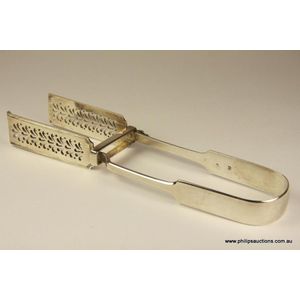George V Sterling Silver Salver, Sheffield 1918
You must be a subscriber, and be logged in to view price and dealer details.
Subscribe Now to view actual auction price for this item
When you subscribe, you have the option of setting the currency in which to display prices to $Au, $US, $NZ or Stg.
- Sterling Silver - Sterling silver is a mixture of 92.5% pure silver and 7.5% of another metal, usually copper. Fine silver is 99.9% pure silver, and is relatively soft and the addition of the very small amount of copper gives the metal enough strength and hardness to be worked into jewellery, decorative and household objects.
- George V - George V (1865 ? 1936) was King of the United Kingdom and the British Dominions, and Emperor of India, from 1910 until his death in 1936.
- Salver - A plate or tray used for the formal offering of food, drink, letters or visiting cards, usually of silver plate, silver or silver-gilt. Large, heavy, oblong or oval silver salvers evolved into what we know as trays in the 18th century. Small, flat salvers are known as waiters.
- Hallmarks - A mark stamped on articles of precious metals in Britain, since the 14th century, certifying their purity. It derives its name from the Guild Hall of the Goldsmiths' Company, who recieved its Charter in 1327 giving it the power to assay (test the purity) and mark articles of gold and silver.
The hallmark will consist of several marks, including the:
- silver standard mark, indicating the purity of the metal. Sterling silver is .925 pure silver.
- the city mark indicating the city in which it was assayed eg London, Birmingham, York etc.
- the date mark, usually a letter of the alphabet in a particular font and case,
- a duty mark, indicating whether duty had been paid to the crown, and only in use from 1784 to 1890
The piece may include an additional mark, the maker's mark, although not forming part of the hallmark, will be located in the vicinity of the hallmarks.
Sometimes silver plated items will bear faux hallmarks, often confusing those not familiar with silver markings.
This item has been included into following indexes:
Visually similar items

Pair sterling silver bright cut sugar tongs, Peter & Ann Bateman 1798

Three Georgian silver meat Skewers by Jonathan Hayne, London 1827, Walter Tweedie, London 178O, Richard Britton, London 1817, each of typical form with ring handle, the Jonathan Hayne example with horse crest, 321 grams in total.Provenance: Purchased from

A pair of sterling silver asparagus tongs, 1852 London, with unclear maker's marks of four initials within a cartouche, the tongs of typical form with a pierced fan like motif to the rectangular blades, hallmarked to the inside stem and also to the strap f

Two pairs of sterling silver sugar tongs 1851/2 London, with maker's marks for Robert Rutland 1966/7 London, with maker's marks for Wakely & Wheeler. AGeorgian thread and shell pair, and a pierced pair with knot weave arms and shell form spoons; hallmarked
